Lithuania and Poland 2007
It was around the middle of 2007 that the residents of Bognor Regis and many other towns started to notice things changing. Polish and Lithuanian registered cars were parked all around the town, strange languages were heard in the shops and markets, and totally unreadable adverts were appearing in the windows of newsagents. People were grumbling about the place being taken over by immigrants who seemed to be above the law when it came to motoring offences and were believed to be receiving favours in the benefit system. It was said that they came here to escape from terrible economic and social conditions at home.
I decided to make it my business to find out what it was like where they came from, and then I would at least be able to grumble about them with some authority. In 2006 I had spent a long weekend in Estonia and Latvia, but far fewer immigrants came from those countries.
As usual I made all the arrangements on the internet, and on 17th October I departed from Gatwick Airport on Air Baltic flight BT656 to Vilnius in Lithuania. The airline, which only has about 10 planes, was very efficient and the flight arrived early. The scheduled arrival time was 21.55, which caused me some concern, because I felt that it was rather late to be arriving in a strange city and finding my way to a strange hotel. There were warnings in the guide books about being picked up by pirate taxis waiting at the airport, but in fact all the taxis in front of the terminal were clearly marked, and although the driver did not speak English he took me straight to the hotel in about 10 minutes.
The hotel was called the Europolis, and, unsurprisingly I suppose, had a slight Greek touch about its architecture. It was small but quite new, and apart from a six inch high step at the threshold of the en-suite bathroom, which caused me to stub my toe every time I went in and almost fall flat on my face every time I came out, there was little to complain about.
The next morning I set off to look round the city. The pavements were in a dreadful state, and it was almost 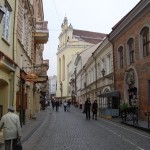 impossible to tow my wheelie case, which I was taking to the main station to put it into the left luggage office until the middle of the afternoon, when I was going to pick up my car. Like most other former East European cities, there was a lot of restoration work going on, with road works and scaffolding everywhere. Some of the old buildings were crumbling in a big way, but in the centre there were many fine civic buildings and a beautiful cathedral. Unfortunately shortly before mid-day it started to pour with rain, but nevertheless after a look round the market I walked up to the Hill of Three Crosses, a notable monument high above the city, from which there is a view of the whole area.
impossible to tow my wheelie case, which I was taking to the main station to put it into the left luggage office until the middle of the afternoon, when I was going to pick up my car. Like most other former East European cities, there was a lot of restoration work going on, with road works and scaffolding everywhere. Some of the old buildings were crumbling in a big way, but in the centre there were many fine civic buildings and a beautiful cathedral. Unfortunately shortly before mid-day it started to pour with rain, but nevertheless after a look round the market I walked up to the Hill of Three Crosses, a notable monument high above the city, from which there is a view of the whole area.
By about 2.30 my low cultural capacity was saturated with Vilnius, so I went to collect the car. The Europcar depot was a shop in a narrow side street near the city centre. The young lady in charge was very pleasant, and after dealing with the paperwork she took me through to a yard at the back which was crammed full of cars and introduced me to my VW Polo. Getting the car out of the yard and through the maze of narrow alleys to the street was a real challenge, 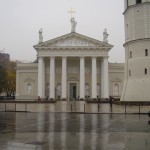 and I was rather relieved that I had been asked to return it to the airport, so I would not have to go through the ordeal again a few days later.
and I was rather relieved that I had been asked to return it to the airport, so I would not have to go through the ordeal again a few days later.
By some miracle I found the road to my night stop, a town called Marijampolė. The young lady had asked where I was going, and when I said "Marry-jam-pole" she repeated the name with a pronun-ciation totally unlike mine, and it is surprising that she knew what I meant.
The Sudajiva guest house in Marijampolė turned out to be very nice, almost good enough for most of my friends and far better than the places I usually stay in. It was close to the centre, so I thought I would have a look round before it got dark. At first sight the town appeared to be quite ordinary, but the shopping area was dominated by a large store like a giant Currys, stacked with domestic appliances and multi-media products. Within a short distance I came across five computer shops and goodness knows how many businesses selling parts for European and Japanese cars. There were few shops selling food or clothes. As I wandered around I was pondering about this strange little Lithuanian town, in which the inhabitants spent most of their disposable income on computers and car parts, when I noticed several Russian registered cars, and the penny dropped. It was not the local people who were buying these products, it was Russians coming through from Kaliningrad, about 15 miles along the road. Kalinigrad is a Russian enclave, sandwiched between Lithuania and Poland, with a stretch of coastline on the Baltic.
The next day the plan was to drive down to a large industrial city called Bialystok in Poland. The Polish border was only a short distance from Marijampolė, but just after entering Poland I diverted for some distance to look at the famous viaducts at Stańczyki, these being all that is left of an abandoned railway line that ran roughly parallel to the border of Kaliningrad. There were few direction signs and no one to ask (perhaps just as well) so after driving around for quite some time I gave up, as there was a lot more that I wanted to do in the day. The countryside was, however, much better than I had expected, heavily wooded with rolling hills, and worth a visit in itself. In the course of looking for the viaducts I drove along a road only 50 meters from the Kaliningrad border, and could clearly see the watchtowers in the forest, although it was not possible to tell if they were manned. There were several tracks leading into the forest with notices and cold war-style striped barriers across them but no one about. There did not seem to be much to stop anyone crossing the frontier in either direction, but I am not sure why anyone would want to.
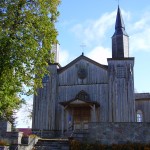 On the way back to the main road leading south I came across a wonderful wooden church in a village. It was the size of a large English parish church, perched high on a mound at the side of the road.
On the way back to the main road leading south I came across a wonderful wooden church in a village. It was the size of a large English parish church, perched high on a mound at the side of the road.
Poland has a dismal road safety record, and within a short time of rejoining the main road (loosely described as a motorway, but mostly similar to the A259 between Bognor and Littlehampton) I came across the first road accident of the day, a crash involving a coach, 2 vans and a minibus. In a distance of 90 miles there were two more serious accidents, a lorry on its side in a field and an Audi awaiting collection after a head-on crash. At times the driving was very hairy, with vehicles overtaking in the face of oncoming traffic, and if you don't join in the people behind will force their way past, practically pushing you off the road. It reminded me of the many trips I made down the A20 in my Mini Cooper when I was 23.
The next town on the route was Suwalki, and on the approach there was a vast Soviet style housing estate, with concrete blocks as far as the eye could see. The buildings were, however, bright and clean looking rather than the dismal grey that they had probably once been. Suwalki seemed to be a reasonably pleasant town, although there was a traffic jam in the main street.
About 30 years ago a friend in England sent me a message on a postcard with a picture of Bialystok on it. He had bought the card in a shop in England and had no idea where Bialystok was. It showed a nondescript building, and he 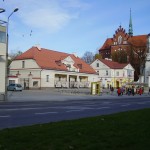 had written "well worth a visit" on it. Whether it would be worth a visit I did not know, but I thought it would be more typical of the real Poland than places like Warsaw or Krakow, which are tarted up show pieces.
had written "well worth a visit" on it. Whether it would be worth a visit I did not know, but I thought it would be more typical of the real Poland than places like Warsaw or Krakow, which are tarted up show pieces.
One of the things I had intended to do in Poland was to go to a branch of Lidl if I could find one. Lidl in Bognor is permanently full of Polish people, so I thought it would be an interesting experience to be an English person in Lidl in Poland. Rather to my surprise, at the first major junction in Bialystok there was a sign pointing to the right saying TESCO 200m. I never did find a Lidl.
The Hotel Trio was on an industrial estate, and despite having been built in 2002 had a distinctly art deco appearance. It also had a very good secure car park, which is vital anywhere in Eastern Europe. I arrived at about 2.00pm, and after getting sorted I decided to walk into town, because I would see more that way.
Bialystok with a population of about 300,000, is close to the border with Belarus, and was directly on the route taken by the Germans when they invaded Russia. Before the war about 60% of the inhabitants were Jewish, and when the Germans came vast numbers were killed on the spot or sent to concentration camps. Presumably that accounts for what happened when I went into a self-service restaurant to get something to eat. There were various dishes on offer, and I was not sure what some of them were. There was a lady standing behind the counter, and I said slowly "Do you speak English?". She shook her head, so I said, rather more quickly, "Sprechen Sie Deutsch". Her expression changed to what I can only describe as a look of pure hatred. She served me when I pointed to what I wanted, and when I said "Thank you" she curled her lip up and snarled "Bitte schön" contemptuously. She was far too young to remember the war, but it put me off attempting to speak German again in Poland.
The central area of the city was actually quite clean and pleasant, with a fair number of good buildings, and the overall standard of architecture was better than typical British post-war rebuilding. There were lots of people around, and the place did not give the impression of being run down. As in many other parts of Eastern Europe, most of the heavy industry has finished and there was no obvious air pollution.
The next morning I got up early, as I was planning to drive a long way, and when I came down into the reception I was surprised to find the whole place in darkness, apart from a dim light behind the receptionist, who was sitting at the desk reading a book. I said "Oh, I thought breakfast was at 7.00". She said "It is, it's 6.20 now". For a moment I stood rooted to the spot, as the truth dawned. The previous day I had driven due south from Lithuania, and had completely forgotten that there was a one hour time difference at the border. I crawled silently back upstairs, and reappeared for breakfast at 7.10.
The intention was to drive back to Lithuania on a country route, looking at towns and villages on the way, and reaching a place called Grutus Park early in the afternoon. I had a good map of Lithuania, but all I had of Poland was an A4 sized photocopy of the immediate area, and I had gone 12 miles on the wrong road out of Bialystok before I realised my mistake and had to retrace my steps. The guide books made a big issue of a village called Bohoniki, with old wooden houses. It was miles from anywhere, and by the time I got there it was a bit of an anti-climax, not really worth making a detour for. I stopped for a while at a small town called Dabrowa-Bili, and then set off for the Lithuanian border. It was a dead straight, bumpy concrete road through flat open countryside, with farms dotted around and the 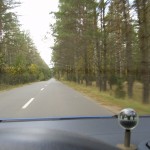 sun shining on the minarets of village churches in the distance. Just how I had imagined Poland to be. After 10 miles I suddenly realised that the sun was in the wrong place, and stopped to look at the map. It turned out that I was going due east instead of north, and was only 2 miles from Belarus. There was no border crossing on that road, which explained the almost total lack of traffic. Another 10 miles back to Dabrowa-Bili, and finally on the right road to Lithuania. I could have saved a lot of time and money by buying a proper map.
sun shining on the minarets of village churches in the distance. Just how I had imagined Poland to be. After 10 miles I suddenly realised that the sun was in the wrong place, and stopped to look at the map. It turned out that I was going due east instead of north, and was only 2 miles from Belarus. There was no border crossing on that road, which explained the almost total lack of traffic. Another 10 miles back to Dabrowa-Bili, and finally on the right road to Lithuania. I could have saved a lot of time and money by buying a proper map.
The border crossings are quite quaint, with the Polish and Lithuanian officers sitting in adjacent rooms in a building at the roadside, with an open window between them. You give your passport to the first one, who looks at it, passes it through the window to the other one, who looks at it and you drive forward and collect it from him or her. The ridiculous thing is that there is a time difference of one hour between the rooms.
Shortly after re-entering Lithuania I discovered why foreigners are advised not to drive after dark. As I rounded a long right-hand bend I saw an extraordinary animal standing on the grass verge facing the road. It looked like something out of a pre-history book, with a massive body covered with long dark brown fur and a large square head low down at the front. At the last minute it decided to cross the road, causing me to brake quite hard. When I got home I looked it up on the internet, and found that it was a bison, the largest animal living in the wild in Europe. They were native to the area, died out, and have been reintroduced in recent times. There is still an original colony living either side of the border between Poland and Belarus, some distance to the south.
The next stop was a truly amazing theme park, officially called Grutus Parkas, but popularly known as Stalin World. During the years of the Soviet Union, right through into the 1980s, the Russians erected statues of political and military heroes in towns all over Lithuania to remind the local populace of how lucky they were to live under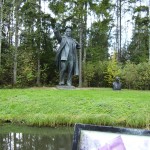 communist rule. When the country became independent in the early 1990s these statues were removed, in some cases literally toppled from their plinths, and mainly finished up on council dumps. Some years ago a former professional wrestler who became a wealthy businessman decided to round up as many of them as he could find and set them up in an area of woodland near a village called Grutus close to the border with Belarus. The 84 statues, of stern-faced individuals or groups, are placed alongside a winding path through the forest, with rousing communist music played through loudspeakers along the route. There is a large library containing the works of Marx, Engels and other father figures of the movement, and tea rooms with a children's playground. Also a train which is supposed to have taken people who did not appreciate what was being done for them to labour camps. The whole project is controversial, with some people saying it is profiting from other people's misery. However, when I was there plenty of people seemed to be enjoying it.
communist rule. When the country became independent in the early 1990s these statues were removed, in some cases literally toppled from their plinths, and mainly finished up on council dumps. Some years ago a former professional wrestler who became a wealthy businessman decided to round up as many of them as he could find and set them up in an area of woodland near a village called Grutus close to the border with Belarus. The 84 statues, of stern-faced individuals or groups, are placed alongside a winding path through the forest, with rousing communist music played through loudspeakers along the route. There is a large library containing the works of Marx, Engels and other father figures of the movement, and tea rooms with a children's playground. Also a train which is supposed to have taken people who did not appreciate what was being done for them to labour camps. The whole project is controversial, with some people saying it is profiting from other people's misery. However, when I was there plenty of people seemed to be enjoying it.
From Grutas Parkas I diverted slightly from the route to my night stop in Alytus to look at an old spa town called Druskininkai. It had an air of faded gentility, but actually appeared to be thriving.
Alytus is a medium-sized town (pop. 68,000), and as usual I had booked the hotel on the internet. It was called the Odė, and quite central, but difficult to find. It turned out to be almost new and was perfectly ok, with a bar but no restaurant. By the time I had got sorted it was pitch dark outside, but I went out to find somewhere to eat. It seemed to be quite safe to walk around, and the town appeared to have lots of open spaces and on the face of it was not much different from a town of similar size anywhere in Western Europe. I found a restaurant where I could see the food before ordering, thereby avoiding the risk of getting the Lithuanian equivalent of steak tartar or sheep's eyes.
In the morning I wanted to leave early, and breakfast was not officially until 9.00. The evening before I asked the young lady in charge if I could eat earlier, at 8.00 if possible, and she said she would arrange it. When I came down to the breakfast room at 8.00 everything was ready, and as I had breakfast she told me she had worked in London for 6 months, which explained her excellent English. She thought the British were great people and could not wait to get back. As I left I gave here a big tip for getting up early, and rather to my surprise, she gave me a big kiss on the cheek.
The drive to Vilnius was faster than I expected, and it left me sufficient time to divert to Trakai, an old village a few miles to the west of Vilnius, on the edge of a lake. The village is a tourist attraction, as is the castle on an island in the 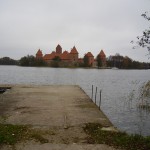 middle of the lake. It was a bright Sunday morning, and quite cold, but preparations were being made for the expected influx of visitors, with people setting up stalls to sell souvenirs and food at the lakeside. I left just as things were starting to get busy.
middle of the lake. It was a bright Sunday morning, and quite cold, but preparations were being made for the expected influx of visitors, with people setting up stalls to sell souvenirs and food at the lakeside. I left just as things were starting to get busy.
When I got to the airport there were spaces marked out for rental cars, but no way of raising the barrier to get to them, so I had to leave the car in a public car park. The Europcar office in the terminal was closed, with a notice instructing customers to put the documents and keys in through a slot. I am never very happy about this arrangement, which I have come across before, but shortly before I went through into the departure lounge a man appeared in the office and said he had moved the car and everything was in order.
In Britain, the USA, France and Germany I have seen places grimmer than anywhere I went in Lithuania and Poland, and the incentive for young people to come to Britain was undoubtedly mainly financial. Until the recession they could earn two or three times as much here as at home and by sharing accommodation they could make enough to buy a flat in Poland in 2 years.
Eastern Europeans are not, in general, very warm and friendly, but apart from the lady who thought I was German everybody I met was helpful and enough people spoke English to make it easy to get around. The local languages are impossible to read or speak unless you are prepared to study them properly. Prices were considerably lower than here but not as cheap as I expected.